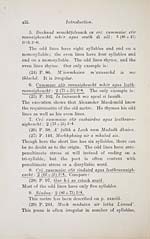Download files
Complete book:
Individual page:
Thumbnail gallery: Grid view | List view

Introduction. xli.
(18) P. 131, Slàn a chaoidh le ceòl na clnrsaich.
In all of which penultimate stress replaees at will the
dissyllabic encìing. It appears also in three stanzas otf
(19) P. 61, Rainn Ghearradh-arm. ^
4. Sneadhhhairdne (Snedbairdne): 2 (82 + 42) 2 + 4. ^
The couplet eonsists of a Hne of eight syllables i
ending on a dissyllable plus a hne of four syllables
ending on a dissyllable. The couplets rhyme. The
best specimens are : —
(20) P. 259, An Duanag Ullamh.
(21) P. 172, Tha sgeul agam dhuibh ri iìDiscadh.
Less accurate are : —
(19) P. 61, Chunnaic vii an dingh a' clilach
bhuadhach.
(22) P. 209, Is fhada tha niisc ann wo cìiodal.
(23) P. 9, ^4 Thì mhòir a chruthaich na diiilean.
The last is influenced strongly by stress. AII, how-
ever, are excellent poems. Most of Alexander
MacDonald's Birlinn is in this metre.
For comparison we may take two quatrains from
an ancient poem ascribed to Colum Cille : —
Mellach lem bhith ind ucht ailiuin
for beind cairrge,
conacind and ar a mheinci
fèth na fairrci.
Conacind a tonda troma
uas ler lethan,
amail canait ceòl dia n-athair
for seòl bethad.^
1 Pleasant, methinks, to be on an isle's breast, on a pinnacle
of rock, that I might see there in its frequency the ocean's
aspect. So that I might see its weighty billows over the broad
Bea, how they sing music to their Father, thi-oughout hfe's
(18) P. 131, Slàn a chaoidh le ceòl na clnrsaich.
In all of which penultimate stress replaees at will the
dissyllabic encìing. It appears also in three stanzas otf
(19) P. 61, Rainn Ghearradh-arm. ^
4. Sneadhhhairdne (Snedbairdne): 2 (82 + 42) 2 + 4. ^
The couplet eonsists of a Hne of eight syllables i
ending on a dissyllable plus a hne of four syllables
ending on a dissyllable. The couplets rhyme. The
best specimens are : —
(20) P. 259, An Duanag Ullamh.
(21) P. 172, Tha sgeul agam dhuibh ri iìDiscadh.
Less accurate are : —
(19) P. 61, Chunnaic vii an dingh a' clilach
bhuadhach.
(22) P. 209, Is fhada tha niisc ann wo cìiodal.
(23) P. 9, ^4 Thì mhòir a chruthaich na diiilean.
The last is influenced strongly by stress. AII, how-
ever, are excellent poems. Most of Alexander
MacDonald's Birlinn is in this metre.
For comparison we may take two quatrains from
an ancient poem ascribed to Colum Cille : —
Mellach lem bhith ind ucht ailiuin
for beind cairrge,
conacind and ar a mheinci
fèth na fairrci.
Conacind a tonda troma
uas ler lethan,
amail canait ceòl dia n-athair
for seòl bethad.^
1 Pleasant, methinks, to be on an isle's breast, on a pinnacle
of rock, that I might see there in its frequency the ocean's
aspect. So that I might see its weighty billows over the broad
Bea, how they sing music to their Father, thi-oughout hfe's
Set display mode to: Large image | Transcription
Images and transcriptions on this page, including medium image downloads, may be used under the Creative Commons Attribution 4.0 International Licence unless otherwise stated. ![]()
| Early Gaelic Book Collections > Matheson Collection > Bardachd Ghaidhlig > (45) |
|---|
| Permanent URL | https://digital.nls.uk/76423056 |
|---|
| Description | Specimens of Gaelic poetry 1550-1900. |
|---|---|
| Shelfmark | Mat.50 |
| Additional NLS resources: | |
| Attribution and copyright: |
|
| Description | Items from a collection of 170 volumes relating to Gaelic matters. Mainly philological works in the Celtic and some non-Celtic languages. Some books extensively annotated by Angus Matheson, the first Professor of Celtic at Glasgow University. |
|---|
| Description | Selected items from five 'Special and Named Printed Collections'. Includes books in Gaelic and other Celtic languages, works about the Gaels, their languages, literature, culture and history. |
|---|

